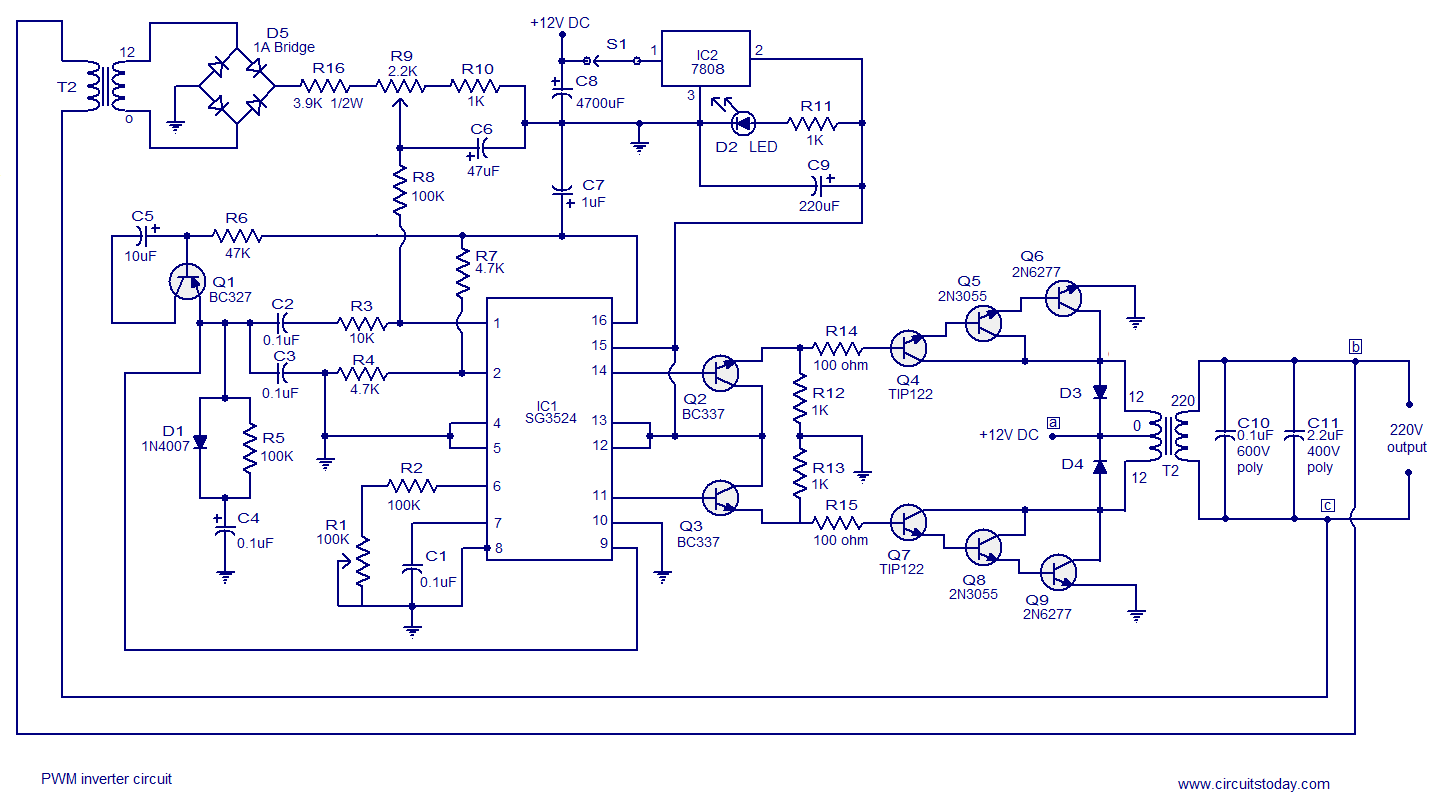250W PWM inverter circuit SG3524.
A 250W PWM inverter circuit built around IC SG3524 is shown here. SG3524 is an integrated switching regulator circuit that has all essential circuitry required for making a switching regulator in single ended or push-pull mode. The built in circuitries inside the SG3524 include pulse width modulator, oscillator, voltage reference, error amplifier, overload protection circuit, output drivers etc. SG3524 forms the heart of this PWM inverter circuit which can correct its output voltage against the variations in the output load. In a non PWM inverter the change in output load directly affects the output voltage (when output load increases output voltage decreases and vice versa), but in a PWM inverter the output voltage remains constant over a range of output load.
Circuit diagram of 250W PWM inverter.
About the circuit.
Resistor R2 and capacitor C1 sets the frequency of the ICs internal oscillator. Preset R1 can be used for fine tuning of the oscillator frequency. Pin 14 and pin 11 are the emitter terminals of the internal driver transistor of the IC. The collector terminals of the driver transistors (pin 13 and 12) are tied together and connected to the +8V rail (output of the 7808). Two 50Hz pulse trains which are 180 degree out of phase are available at pin 14 and 15 of the IC. These are the signals which drive the subsequent transistor stages. When signal at pin 14 is high, transistor Q2 is switched on which in turn makes transistor Q4, Q5, Q6 ON are current flows from the +12V source (battery) connected at point a (marked with label a) through the upper half of the transformer (T1) primary and sinks to ground through the transistors Q4, Q5 and Q6. As a result a voltage is induced in the transformer secondary (due to electromagnetic induction) and this voltage contributes to the upper half cycle of the 220V output waveform. During this period pin 11 will be low and its succeeding stages will be inactive. When 11 of the IC pin goes high Q3 gets switched ON and as result Q7, Q8 and Q9 will be also switched ON. Current flows from the +12V source (marked with label a) through the lower half of the transformer primary and sinks to the ground through transistors Q7, Q8, Q9 and the resultant voltage induced at the T2 secondary contributes to the lower half cycle of the 220V output wave form.
The output voltage regulation section of the inverter circuit works as follows. The inverter output (output of T2) is tapped from point’s labelled b, c and supplied to the primary of the transformer T2. The transformer T2 steps down this high voltage , bridge D5 rectifies it and this voltage ( will be proportional to the inverter’s output voltage) is supplied to the pin1 (inverting input of the internal error amplifier of the IC) through R8, R9, R16 and this voltage is compared with the internal reference voltage. This error voltage will be proportional to the variation of the output voltage from the desired value and the IC adjusts the duty cycle of the drive signals ( at pin 14 and 12) in order to bring back the output voltage to the desired value. Preset R9 can be used for adjusting the inverters output voltage as it directly controls the amount of voltage fed back from the inverter output to the error amplifier section.
IC2 and its associated components produce an 8V supply from the 12V source for powering the IC and its related circuitries. Diodes D3 and D4 are freewheeling diodes which protect the driver stage transistors from voltage spikes which are produced when the transformer (T2) primaries are switched. R14 and R15 limit the base current of Q4 and Q7 respectively. R12 and R13 are pulldown resistors for Q4 and Q7 which prevents their accidental switch ON. C10 and C11 are meant for bypassing noise from the inverter output. C8 is a filter capacitor for the voltage regulator IC 7805. R11 limits limits the current through the indicator LED D2.
Notes.
- Mount the SG3524 on a holder.
- All capacitors other than C10 and C11 must be rated at least 15V.
- Preset R9 can be used for adjusting the inverter’s output voltage.
- Preset R1 can be used for adjusting the inverter’s operating frequency.
- Transistors in the driver stage require heatsink.
- T2 is a 220V primary, 12V secondary, 1A transformer.
- T1 is a 12-0-12 V primary, 220V secondary, 300VA transformer.
- Driver transistors must be isolated from the heatsink using mica sheets. Mounting kits for these transistors are easily available in the market.
- An optional finned aluminium heatsink can be attached to the 7808.
- If 1A bridge is not available, make one using four 1N4007 diodes.
